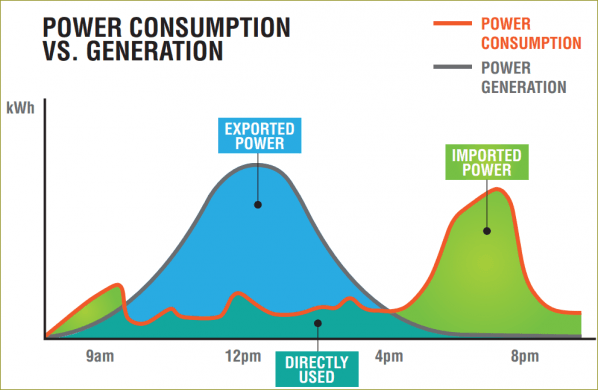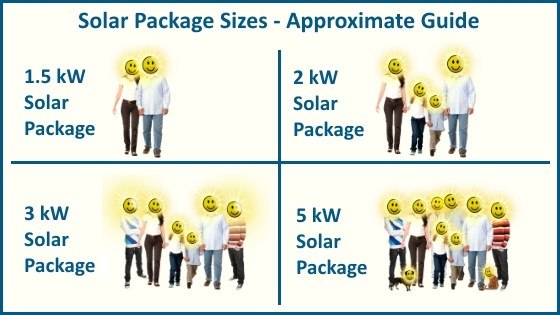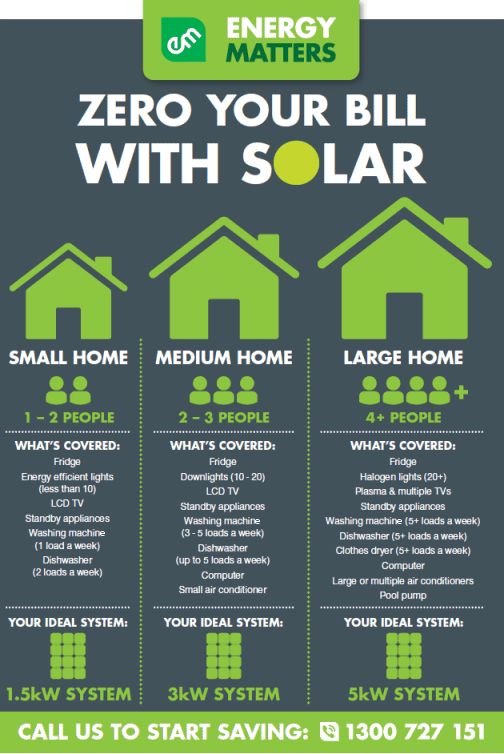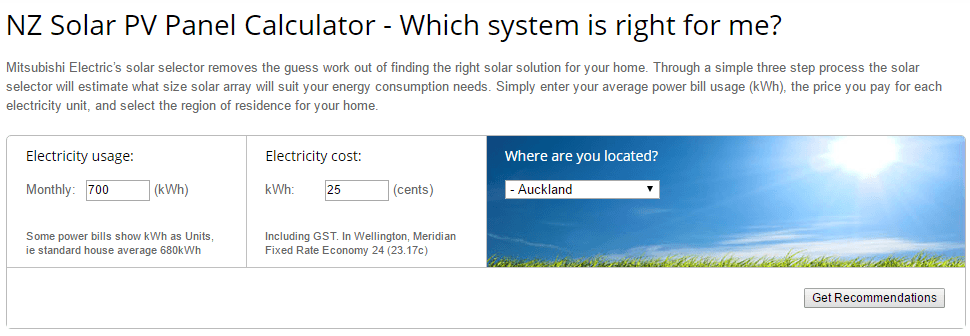What solar power system size is best?
The perfect system size will depend most of all on you. No matter whether you are a homeowner or a business owner.
- Your solar goals – personal, environmental and financial
- Your power consumption habits
- Where you live and how much sunlight you get, and (of course)
- Your budget.
I’ll guide you through the right ways, and wrong ways, to determine your solar power system size in an unbiased, data-driven way.
I want to ensure that you get the most out of your solar power system and don’t get ripped off.
Read from the start, or use the menu to skip to the sections you are most interested in.
Contents
The Basics of Solar Sizing
Buy-back rates are (unfortunately) rubbish
There has recently been an uproar from solar customers in Australia as their government has moved away from subsidising solar with artificially high buy-back rates.
If you don’t know what I’m talking about, I’ll back up a moment. With solar, if you’re not using the power generated by your panels then it is typically exported to the local power grid for others to use. You do get paid for this excess energy. The rate is known as the ‘solar buy-back rate’ in NZ or ‘feed-in tariff’ overseas.
So back to Australia, they now have an unsubsidised solar environment now very similar to NZ (hence the uproar I guess!).
In NZ, although you might pay 25¢ for each unit of power you from your power company, if you export excess power during the day you’ll only receive a paltry 7¢ – 8¢ for each unit sold back. Therefore :
To ensure the best return on your solar investment, the amount of power you generate must be matched to your power consumption habits.
The chart below from demonstrates a typical residential solar scenario, showing the timing difference between what you generate and what you use. My family is no different, we use most of our power when the kids get home from school, I’m cooking tea, Mrs Power Guy is popping the washing on etc.

Self-Consumption is the aim
The importance of matching generation to consumption is known as also referred to as ‘self-consumption’.
You should aim to use your solar power, not export it.
This can be done in a number of ways. By utilising battery storage (currently not economic), altering your power usage habits, using a smart solar controller or all of the above.
The most important step is to ensure your system is sized correctly in the first place. Otherwise, you are gambling that your system will achieve your solar goals. This is why I am writing this article, to help you install the most efficient solar system for you.
Options for Solar Power System Sizing (in brief)
There are a couple of options for sizing a solar power system. I’ll summarise them quickly here, then go into more detail on each below.
‘Rule of Thumb’ Sizing
This is a basic method, best used at a local level by a trusted solar power installer who has a solid understanding of the local area.
Based on their experience with other customers and their solar performance, they can recommend a certain size for your installation.
Your Power Bill
This method is often used in conjunction with the ‘rule of thumb’ sizing and is common for solar installers, online solar calculators and panel manufacturer websites.
The recommendation could be for a solar power system that generates 50% of your average monthly energy consumption.
For increased accuracy, there must be some input from the home or business owner on their power usage habits to get at least a roughly accurate result.
Actual Consumption Profile
This is the gold standard for sizing a solar system and is especially important if you are using a lot of power, such as a large home or business premises.
Historical usage data from your power meter is reviewed to understand your typical daily and seasonal power usage. Sizing your solar investment based upon actual consumption is the best way to avoid over or under-sizing.
Sizing Outcome
What you should aim to determine is the ideal amount of generation you require from your solar power system.
This allows you to talk specifics with potential solar providers.
Sizing Constraints
Once you have determined the generation required from your solar system, the next step is to look at the practicalities of installation and cost.
Available Roof Area
One major restriction may be the available, suitable roof area for your solar installation. This is covered in more detail under solar panel sizing below.
Also consider the condition of your roof. Is it likely to need painting or replacement anytime soon?
Your Budget
The second major restriction is often the installed system cost. How much can you afford to invest in a solar power install?
Return on Investment
If you are planning to move on from your property within the next five to seven years, you need to consider whether you will get the expected return on your investment.
Will the new owner pay a premium price to reflect the solar installation? Will they care if the solar installatioin is 5kW or 10kW?
Grid-tied vs Off-grid
This sizing guide is focused on grid-tied solar and helping get the best ‘bang for your buck’.
If you are going off-grid, then a lot more thought needs to go into the sizing decision, coupled with energy efficiency and intelligent storage of surplus energy.
New Zealand Average Installation Sizes
Residential installations in NZ can vary from a small 1.5 kW installation, up to sizable three-phase solar systems of 10 kW or more.
Back in 2016, there were around 11,000 residential and small commercial solar installations according to the Electricity Authority and the number of installations was increasing by around 30% per year. The average installed system size was around 3.6kW (~8 panels).
For residences, a system size around 3 kW is popular. A 3 kW installation will generate enough energy to make a significant dent in your power bill, while still being in the $10,000 or less price range.
Fast forward to 2025, the average installed system is just over 5.0kW (~11 panels).
More people are looking to totally eliminate their summer power bill and have some spare energy to export.
Sizing Methods in Detail
Rule of Thumb (rough)
As an engineer, I think there is a place for detail, analysis and optimisation. There is also a place for trial and error, ‘rule of thumb’ and local experience.
Experienced solar installers will know their systems and their local area and will get feedback from previous customers on a daily basis.
They will know how previous installations have performed, how much customers they are saving on their power. They will definitely hear about the installations that don’t perform as expected.
Here’s an example from Solar King in Takapuna:

For small to medium consumption residential customers, a ‘rule of thumb’ approach can be appropriate in scenarios where some of the following items apply:
- You are considering a smaller solar installation
- Someone is home during the day
- You are running a home business
- There is the ability to shift load such as your hot water cylinder using timers
- Appliances such as washing machines can be delayed to start during the middle of the day, and/or
- You have a solar system controller, which automates this load shifting.
If some of these items apply, then the risk of dramatically over or under sizing the solar system is pretty low. For residential at least.
I would caution against this type of rough sizing for power hungry residences and definitely for commercial premises. It’s just not accurate enough, and there is a serious risk of exporting significant power, not being able to self-consume and having a detrimental effect on system economics.
Here’s another example from Energy Matters in Australia, which starts to also consider your home appliances.

Power Bill (most common)
Probably the most common means of sizing a solar installation is look at recent power bills, and then sanity check against the solar installer’s experience or ‘rule of thumb’ guide.
As it is a data-driven approach, using your actual power bills, it’s also often the method adopted by online solar calculators and panel manufacturer websites.
Typical questions that will be asked are:
- How much of your power do you want to come from solar?
- What would you like your power bill to be?
- What’s your budget?
Example: Sizing Using Power Bill
For example, my power bill might show that I am using on average 700 kWh (units) of power per month. 700 x 12 = 8400 kWh per year.
The recommendation could be for a solar power system that generates 50% of your average monthly energy consumption. This ‘50%’ figure is also referred to as the ‘grid offset’, i.e. how much of your consumption you are looking to offset with your own generation.
So, to offset 50% of my 8,400 kWh on an annualised basis I would size my system for 4200 kWh per year. Which in Auckland equates to around 3 kW of optimally placed solar generation.
This method can be inspiring for homeowners, dreaming of generating 50% of their own power usage.
It can also be used to provide misleading economics and savings calculations.
Watch the Small Print & Remember the Importance of Self-Consumption
Let’s consider the Mitsubishi Electric online calculator for solar in New Zealand. This is a really simple calculator that recommends you a solar system size based upon power bill data.
All you do is plug in your location, average monthly power usage and average cost of each unit (kWh) or electricity. Then hit Get Recommendations.

If I am in Auckland, using 700 kWh per month and my power company charges me 25c per unit of power – the output looks something like this:

The website matches the closest Mitsubishi solar package to a 50% usage target, which in this case is the 3.24kWp package.
This is kind of handy, but I the stated “Annual Electricity Cost Saved” figure is a total load of rubbish.
For my example, it looks like I will save $1,184.25 (highlighted).
How did they get this figure? Well, it’s all the energy generated by the recommended 3.24 kWp package multiplied by 25c electricity price. Which is totally unrealistic for most people.
Let me demonstrate with a real life example. A friend living north of Auckland has solar. She is at home during the day with two kids, and actively works hard to maximise self-consumption by using appliances such as the washing machine, dryer, dishwasher etc during the middle of the day.
During the sunny month of February, this was her household bill:

What you should notice is that even with her best efforts, during the sunniest part of the day there was still solar power exported. Also, note the difference in price between export and import. Only a pittance paid for exported power.
So… all I am saying is beware or the small print and assumptions when a solar panel manufacturer or installer quotes you savings and payback periods.
Do your homework. Ask them about the assumptions made when they demonstrate a five year or seven year payback period. Look at whether you can realistically shift load to fully utilise your generation.
Or better yet, look at your actual historical consumption and make a fully informed decision.
Actual Consumption (My Gold Standard)
If you are like me and partial to a Tim Tam, you’ll know there is no substitute for quality. Now, where did my wife hide that packet….

Equally, when sizing the output of your solar power system there is no substitute for actual power usage history.
This is the gold standard for sizing a solar system and is especially important if you are using a lot of power, such as a large home or business premises.
A good salesperson may sell you on an amazing payback period based upon shifting almost all of your consumption to the sunniest part of the day. But realistically, in my experience, most people go back to their old habits after a while. Be it six days or six months.
While you used to religiously set you dishwasher for midday, you forget every second day and end up putting it on after dinner.
There may also be some load you can’t shift. Like the oven to cook dinner, TV in the evening, lights when it’s dark and maybe charging the electric vehicle overnight. So it’s important to be realistic.
The best way to do this is obtaining your historical power consumption from your power retailer, and analysing this to determine the optimal solar power system size.
Your actual consumption, you will be able to see the influence of large energy consuming appliances such as heat pumps, air-con, pool heaters, hot water cylinders and lighting.
Here’s my household consumption from Monday this week. I work from home during the day, but our consumption remains pretty low apart from the typical evening peak.

Once you have this data, you can then make an informed decision whether this load can be shifted (manually, or using a smart controller) to the middle of the day to benefit from solar.
Sizing your solar investment based upon actual consumption is the best way to reliably avoid over or under-sizing.
Summary & Recommendations
The perfect system size will depend most of all on you. No matter whether you are a homeowner or a business owner.
The most important point to remember is that your solar system output should match your consumption habits.
This will maximise the return on your solar investment and avoid your panels being just an expensive ornament.
Before you start shopping for solar installers and debating solar panels, inverters and efficiencies – you should first look inwards.
If you can talk to installers intelligently around generation output, you are one step ahead of the game.
Useful Links:
List of Solar Panel Installers
Power Retailer Buy-Back (Export) Rates
